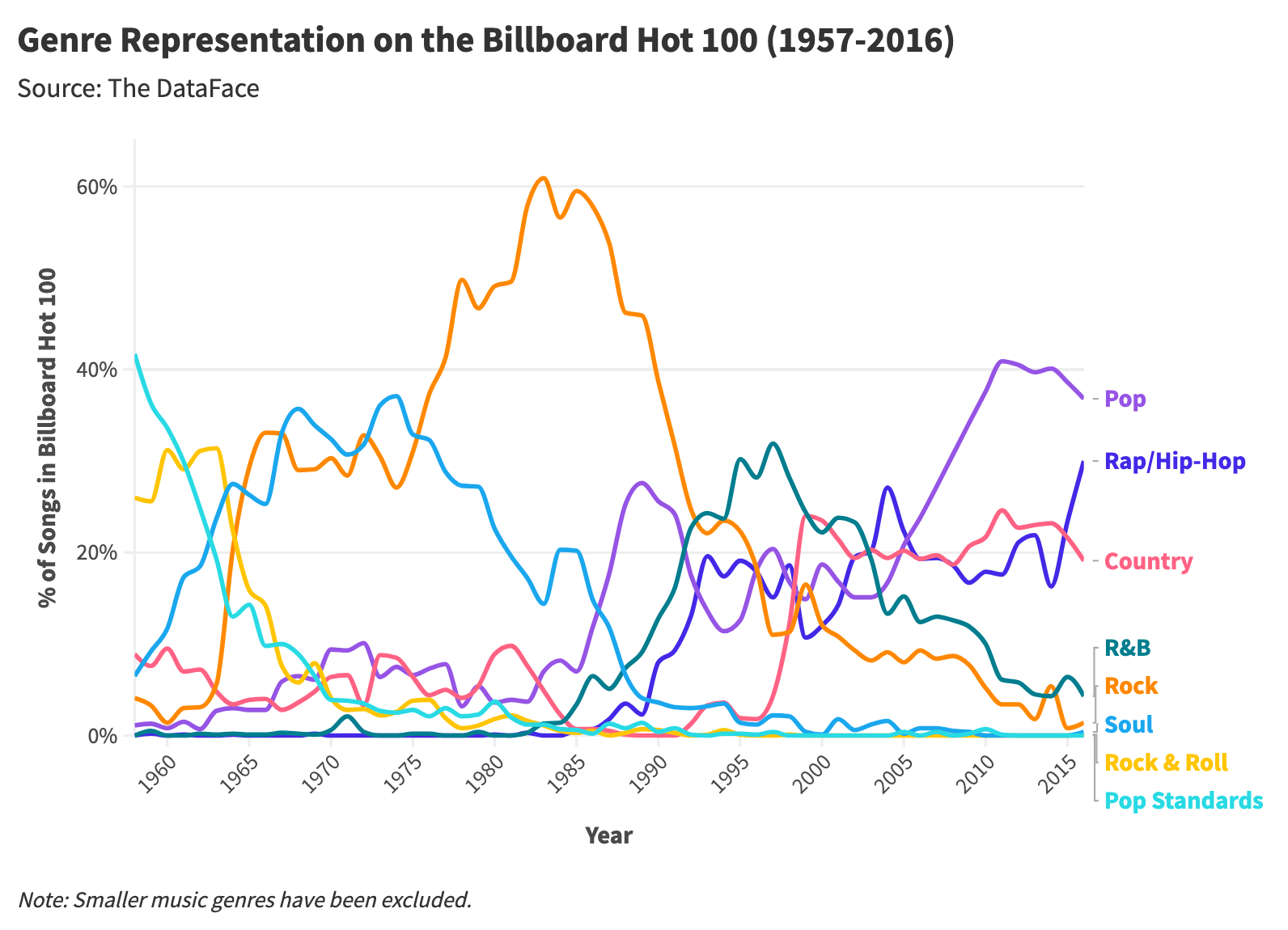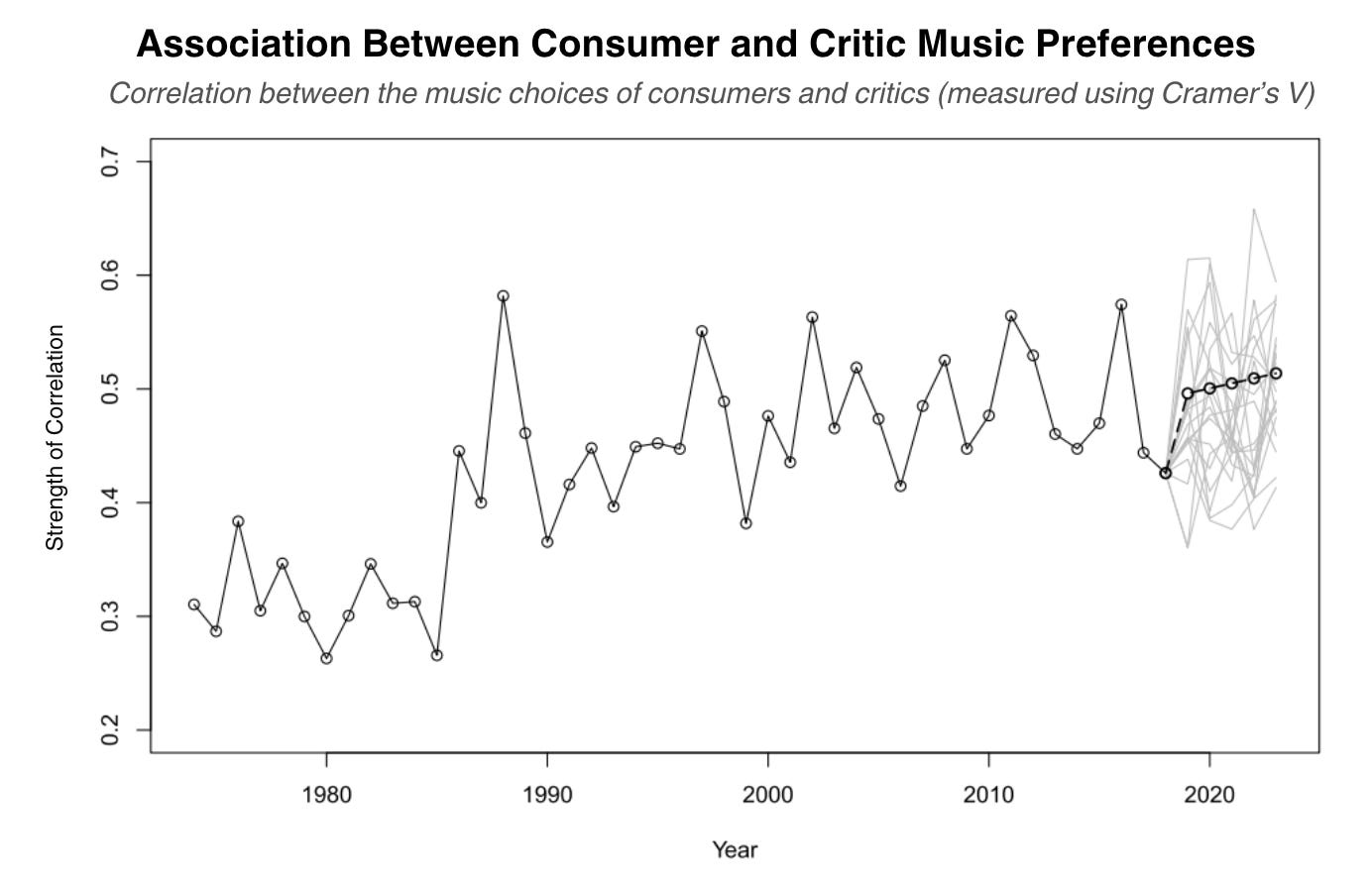

After going cross-eyed, I fixed it.
Posted on 05/04/2025 7:01:31 PM PDT by DoodleBob


After going cross-eyed, I fixed it.
As noted in an earlier comment, the graph makes a distinction between ‘Rock’ and ‘Rock & Roll’, the former clearly on the decline by the mid-60’s and the latter enjoying a peak in the mid 80’s and declining into the noise by the early-mid 90’s.
I would call it Guitar-Driven music.
Nirvana released "Bleach" in June of 1989 without much listener attention. They released "Nevermind" in September 1991 and it took off from there.
Hair metal was already dead. The executives jumped on "the Seattle Sound" and grunge because the hair bands had already dropped off. There are plenty of interviews online where hair bands couldn't understand why their labels were dropping them in 1986-87, and why second tier hair bands couldn't get signed where just a few years prior they were all getting signed. Hair bands were made for MTV and MTV had already changed in 1986. Three of the five original VJs left; J. J. Jackson moved back to Los Angeles and returned to radio, Nina Blackwood moved into different roles in television. Martha Quinn's contract was not renewed in late 1986. She left the network although was brough back in early 1989 and stayed until 1992. In mid-1987, Alan Hunter and Mark Goodman ceased being full-time MTV veejays.
You can see the "metal" shows that ended between 1986-1989, before Nirvana and grunge took over the airwaves in late 1991.
Heavy Metal Mania (1985–1986)
Metal Shop (1986)
Metal Music Half Hour (1986–1987)
Hard 30: MTV's Headbangers Half Hour (1989)
The industry executives sold the lie that grunge took over, instead of admitting they were pushing hyped-up trash onto viewers for several years.
I tell people that Lady Antebellum (now P.C.'d 'Lady A') ripped off Allen Parsons Project. "I Need You Now" sounds like a slightly reworked "Eye in the Sky" to me.
Actually, the "old men" of the '60s would have grown up with turn of the century music, like Ragtime music. Big band fans were in their late 30s and 40s in the 1960s like my Dad.
I forgot to add that MTV launched “MTV Unplugged” in 1989, basically an acoustic recycling of other music in attempt to offset the drop in MTV viewership, and Nirvana didn’t release ‘Nevermind’ until late 1991.
Revolver was the Beatles first LSD influenced psychedelic album.
This is an interesting thread.
I do NOT know what the distinctions are between rock and rock and roll. Or how other genres are defined.
I don’t see any mention of people such as Paul Simon, Barry Manilow, Gladys Knight, Diana Ross, The Bee Gees, and countless others, who have been popular over the decades.
Bt I admit I don’t know the definitions of the different genres of music being discussed. Perhaps none of these others are really rock or rock and roll.
That countdown DJ, KC Kasem, always used to say the rock era started in 1955. But I don’t think he ever made a distinction between rock and rock and roll.
Roots Music is a broad umbrella term for traditional, folk-based music that forms the foundation of many American genres. It emphasizes raw, authentic sounds drawn from cultural "roots" like blues, folk, gospel, country, and early jazz. Roots is the broadest, encompassing the raw, historical foundations of the following genres.
Americana is a modern genre blending roots music traditions (folk, country, blues, bluegrass) with contemporary influences. It’s defined by its eclectic, authentic vibe and resistance to mainstream polish. Americana is a modern, eclectic fusion, pulling from Roots, country, and rock, with a polished yet authentic feel.
Appalachian Music is a regional folk tradition from the Appalachian Mountains (spanning parts of West Virginia, Kentucky, Tennessee, etc.). It’s a subset of Roots music, deeply tied to the area’s Scottish, Irish, and African influences. Appalachian is hyper-regional, traditional, and tied to mountain culture, with a distinct "high lonesome" sound.
Contemporary Folk is a modern evolution of traditional folk music, blending acoustic storytelling with personal, often introspective lyrics. It’s less bound by tradition than Roots or Appalachian music. Contemporary Folk prioritizes personal, lyrical storytelling with a modern, accessible style, less tied to specific traditions.
Old-Time is a precursor to bluegrass and Appalachian music, Old-Time is traditional American folk music from the 19th century, emphasizing dance tunes and ballads.
Singer-Songwriter is introspective, lyric-driven music by solo artists, often acoustic, spanning folk, pop, and indie influences. It extends Contemporary Folk’s emphasis on personal storytelling and minimalism, with a broader emotional palette that can feel Americana-adjacent when rootsy. The sound is acoustic guitar or piano-driven, with soft to mid-tempo melodies. Vocals and lyrics take center stage, sometimes with subtle band backing. Its themes are similar to Contemporary Folk’s poetic bent.
Indie Folk is a modern genre fusing folk’s acoustic simplicity with indie rock’s experimental and atmospheric elements, often dreamy or cinematic. It builds on Contemporary Folk’s introspective lyrics and Americana’s eclectic vibe, adding lush textures that feel fresh yet rooted. Acoustic guitars are layered with electric elements, reverb, and soft percussion. Vocals are emotive, often harmonized.
Eleanor Rigby has entered the chat.
Are You Ready?--Maryann & the Hi-Flyin' Combo (2019)
I listen to music up into the 90s. For country music, my limit is until 1980s.
‘Just take those old records off the shelf
I’ll sit and listen to ‘em by myself
Today’s music ain’t got the same soul
I like that old time rock and rol
I read Sammy Hagar’s biography and he strongly hinted that DLR was gay. When I look back at Van Halen videos from the 80s, after having gay crap pushed on me since Barry Soetoro took office, I now go, “OMG, that guy was SO GAY. How did we not all see it???”
Well, we gotta...
Because I was gonna...
I had MTV on one day when .... Yo! MTV Raps or whatever garbage came on - I wondered what this garbage was - had no idea that so many would buy into that non-music
MTV has (apparently) produced nothing but trash since then
I remember when they had like, music videos
I always say that it started dying pretty fast in the 90’s and by 2000 it was gone. The chart pretty much agrees with that. Once we started getting Britney Spears and New Kids on the Block then we were about cooked.
Disclaimer: Opinions posted on Free Republic are those of the individual posters and do not necessarily represent the opinion of Free Republic or its management. All materials posted herein are protected by copyright law and the exemption for fair use of copyrighted works.